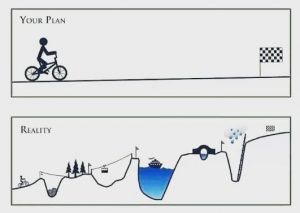“If you don’t know where are you going, it doesn’t matter where you go. Any road will get you there.”
If you want to start a business without writing a solid business plan then you better not start anything.

First of all, understand that writing a business plan requires more thinking than writing.
I remember back at University most important criterion was to have it minimum 30 pages long…
In real life it is much more about the content vs length of the document. Two pages should do for any business plan.
There are couple things you should stick to when writing a business plan:
1.) Write it down
It is utmost important to write it down. Writing helps you think and structure your thinking.
2.) Business plan should fit to 2 pages
You need 1 page for text and 1 page for financials.
3.) Business plan must answer following questions:
a) Who are you?
Who are you as founder? What is your experience, your strengths. What do you bring to business? Your business should be based on your passion and your strengths. It is very likely you will instill your values to the company as its founder so you need to be sure you know your values and your strengths.
b) Who are you as company?
What do you stand for? What should people think about when they hear your company name? What do you offer? What value do you bring to marketplace? How do you make money? What is your business model?
This is classic elevator speech part or “executive summary” if you like. Imagine being at the party and somebody asks you: What do you do? This part should give you clear, concise and to the point answer. After hearing this people must immediately know what you will do and become interested in hearing more.
c) Who are your customers?
Most important question. Without proper understanding of your customers you will never succeed. Everything you do must be based on proper understanding of your customers.
d) How you will do it?
Packaging, pricing, distribution channels, marketing, customers, people… whole thing.
This part tells in rough details how it all will work. No need to go into tiny details as those will be mostly worked once you launch. You need to be very clear on principles and make sure it is based on you customer / market understanding.
e) Financial part
Starting costs
Put together estimates on starting costs. Include also sources of financing you plan to use. It is better to overestimate as costs tend to be higher in reality vs plans.
Basic P&L
Simple P&L showing you how it would work financially. Operational costs on one side and planned revenue on the other. It should tell you if your plan is viable and worthy pursuing.
Revenue streams
Here you should think about all ways how money will flow into company. Again, great understanding of who is your customer will help greatly in designing revenue streams. This can change overtime. Be clear on “business / profit model” you want to pursue (freemium, subscription…)
Great tool is a lean canvas which gives you clear and structured approach to planning your business.
For online canvas making you can use canvanizer or other web based services. Or find template, print it out and work it out with pen and paper.
Related posts: 5 Things To Consider Before You Start Your Business; Should I Quit My Job?